Ultrasonic Monitoring of Setting and Strength Development of Ultra-High-Performance Concrete
Abstract
:1. Introduction
2. Test Program
2.1. Materials, Mixture Proportions, and Mixing Sequence
2.2. Test Equipment and Procedure
2.2.1. Penetration Resistance Test (ASTM C403)
2.2.2. UPV Measurement
2.2.3. Direct Tensile Test
3. Test Results and Discussion
3.1. Setting Characteristics of UHPC by Penetration Resistance Test
3.2. Evolution of UPV
3.3. Early Age Tensile Strength Development
4. Conclusions
Acknowledgments
Author Contributions
Conflicts of Interest
References
- Richard, P.; Cheyrezy, M. Composition of reactive powder concretes. Cem. Concr. Res. 1995, 25, 1501–1511. [Google Scholar] [CrossRef]
- Standard Test Method for Time of Setting of Concrete Mixture by Penetration Resistance; ASTM C403/C403M; ASTM International: West Conshohocken, PA, USA, 2008.
- Yoo, D.Y.; Park, J.J.; Kim, S.W.; Yoon, Y.S. Influence of reinforcing bar type on autogenous shrinkage stress and bond behavior of ultra high performance fiber reinforced concrete. Cem. Concr. Compos. 2014, 48, 150–161. [Google Scholar] [CrossRef]
- Yoo, D.Y.; Park, J.J.; Kim, S.W.; Yoon, Y.S. Early age setting, shrinkage and tensile characteristics of ultra high performance fiber reinforced concrete. Constr. Build. Mater. 2013, 41, 427–438. [Google Scholar] [CrossRef]
- Dao, V.T.N.; Dux, P.F.; Horris, P.H. Tensile properties of early-age concrete. ACI Mater. J. 2009, 106, 483–492. [Google Scholar]
- Pessiki, S.P.; Carino, N.J. Measurement of the Setting Time and Strength of Concrete by the Impact-Echo Method; Report No. NBSIR 87-3575; National Bureau of Standards: Washington, DC, USA, 1987; p. 109. [Google Scholar]
- Pessiki, S.P.; Carino, N.J. Setting time and strength of concrete using the impact-echo method. ACI Mater. J. 1988, 85, 389–399. [Google Scholar]
- Keating, J.; Hannant, D.J.; Hibbert, A.P. Correlation between cube strength, ultrasonic pulse velocity and volume change for oil well cement slurries. Cem. Concr. Res. 1989, 19, 715–726. [Google Scholar] [CrossRef]
- Pessiki, S.; Johnson, M.R. Nondestructive evaluation of early-age concrete strength in plate structures by the impact-echo method. ACI Mater. J. 1996, 93, 260–271. [Google Scholar]
- Demirboğa, R.; Türkmen, İ.; Karakoc, M.B. Relationship between ultrasonic velocity and compressive strength for high-volume mineral-admixtured concrete. Cem. Concr. Res. 2004, 34, 2329–2336. [Google Scholar] [CrossRef]
- Habel, K.; Charron, J.P.; Denarié, E.; Brühwiler, E. Autogenous deformations and viscoelasticity of UHPFRC in structures. Part I: Experimental results. Mag. Concr. Res. 2006, 58, 135–145. [Google Scholar] [CrossRef]
- Cauberg, N.; Remy, O.; Permentier, B.; Pierard, J.; Itterbeeck, P.V. Shrinkage behavior and cracking tendency of UHPC. In Proceedings of the 9th Symposium on High Performance Concrete, Rotorua, New Zealand, 9–11 August 2011.
- Yoo, D.Y.; Min, K.H.; Lee, J.H.; Yoon, Y.S. Shrinkage and cracking of restrained ultra-high-performance fiber-reinforced concrete slabs at early age. Constr. Build. Mater. 2014, 73, 357–365. [Google Scholar] [CrossRef]
- Park, J.J.; Yoo, D.Y.; Kim, S.W.; Yoon, Y.S. Benefits of using expansive and shrinkage-reducing agents in UHPC for volume stability. Mag. Concr. Res. 2014, 66, 745–750. [Google Scholar] [CrossRef]
- Yoo, D.Y.; Shin, H.O.; Lee, J.Y.; Yoon, Y.S. Enhancing cracking resistance of ultra-high-performance concrete slabs using steel fibers. Mag. Concr. Res. 2015, 67, 487–495. [Google Scholar] [CrossRef]
- Kim, Y.J.; Park, S.Y.; Park, J.S.; Kim, B.S. State-of-the-art of UHPC applications in the World. Korean Soc. Civ. Eng. 2013, 61, 39–50. [Google Scholar]
- Reinhardt, H.W.; Grosse, C.U.; Herb, A.T. Ultrasonic monitoring of setting and hardening of cement mortar—A new device. Mater. Struct. 2000, 33, 581–583. [Google Scholar] [CrossRef]
- Lee, H.K.; Lee, K.M.; Kim, Y.H.; Yim, H.; Bae, D.B. Ultrasonic in-situ monitoring of setting process of high-performance concrete. Cem. Concr. Res. 2004, 34, 631–640. [Google Scholar] [CrossRef]
- Lee, I.M.; Kim, J.S.; Yoon, H.K.; Lee, J.S. Evaluation of compressive strength and stiffness of grouted soils by using elastic waves. Sci. World J. 2014, 2014, 215804. [Google Scholar] [CrossRef] [PubMed]
- Yoo, D.Y.; Kang, S.T.; Lee, J.H.; Yoon, Y.S. Effect of shrinkage reducing admixture on tensile and flexural behaviors of UHPFRC considering fiber distribution characteristics. Cem. Concr. Res. 2013, 54, 180–190. [Google Scholar] [CrossRef]
- Kim, J.R.; Suh, Y.C.; Ahn, S.S. Determination of proper application rate of curing compound for cement concrete pavement. Korean Soc. Road Eng. 2005, 7, 45–55. [Google Scholar]
- Keating, J.; Hannant, D.J.; Hibbert, A.P. Comparison of shear modulus and pulse velocity techniques to measure the build-up of structure in fresh cement pastes used in oil well cementing. Cem. Concr. Res. 1989, 19, 554–566. [Google Scholar] [CrossRef]
- Chotard, T.; Gimet-Breart, N.; Smith, A.; Fargeot, D.; Bonnet, J.P.; Gault, C. Application of ultrasonic testing to describe the hydration of calcium aluminate cement at the early age. Cem. Concr. Res. 2001, 31, 405–412. [Google Scholar] [CrossRef]
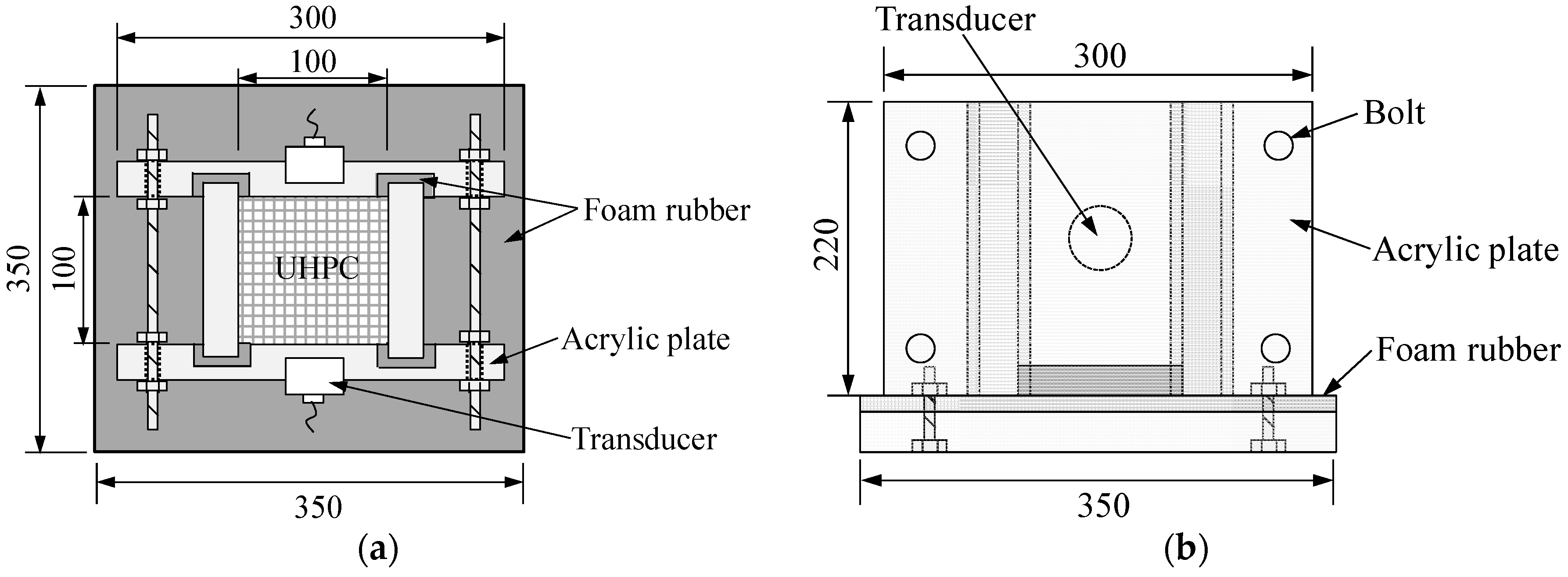
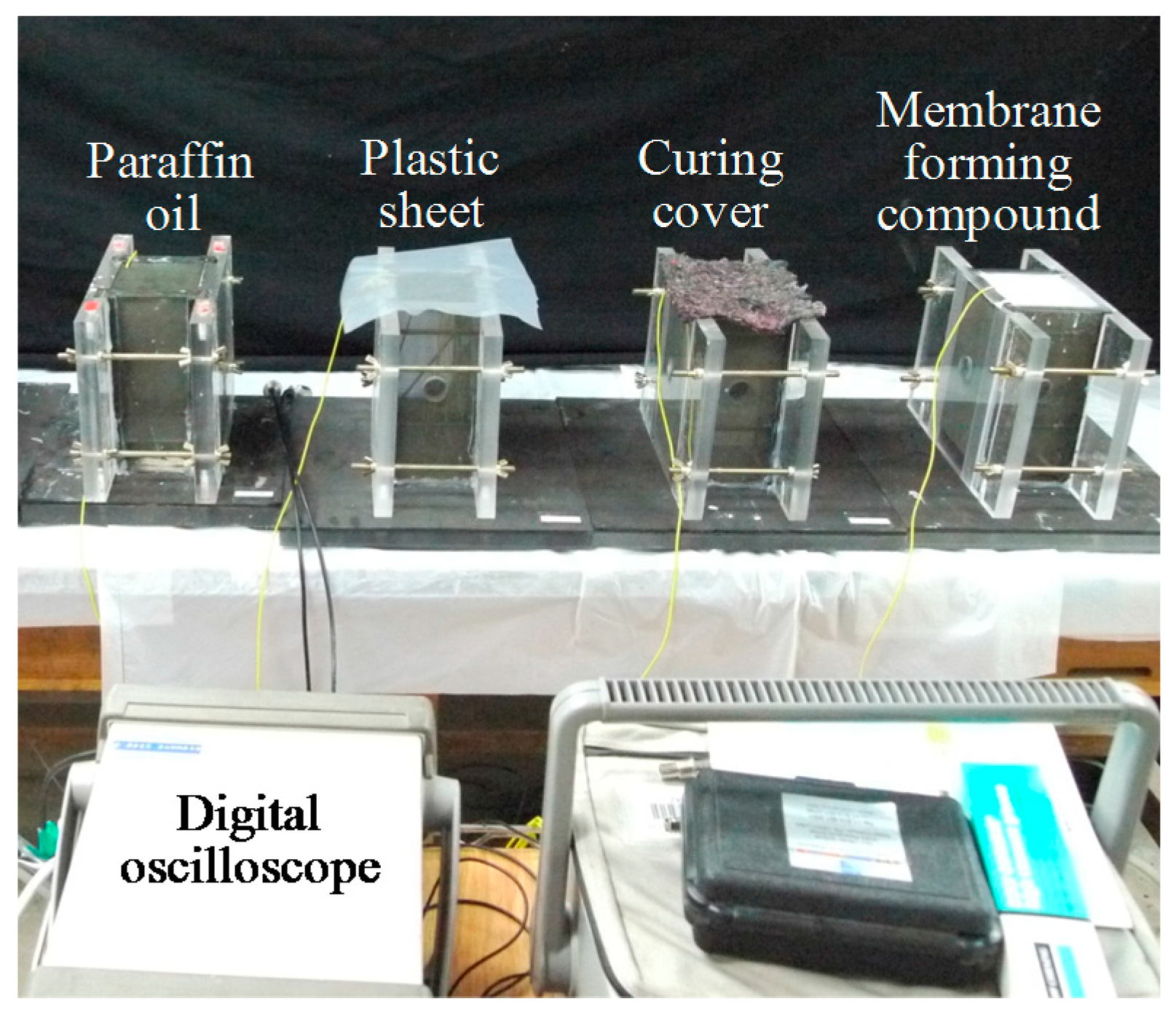

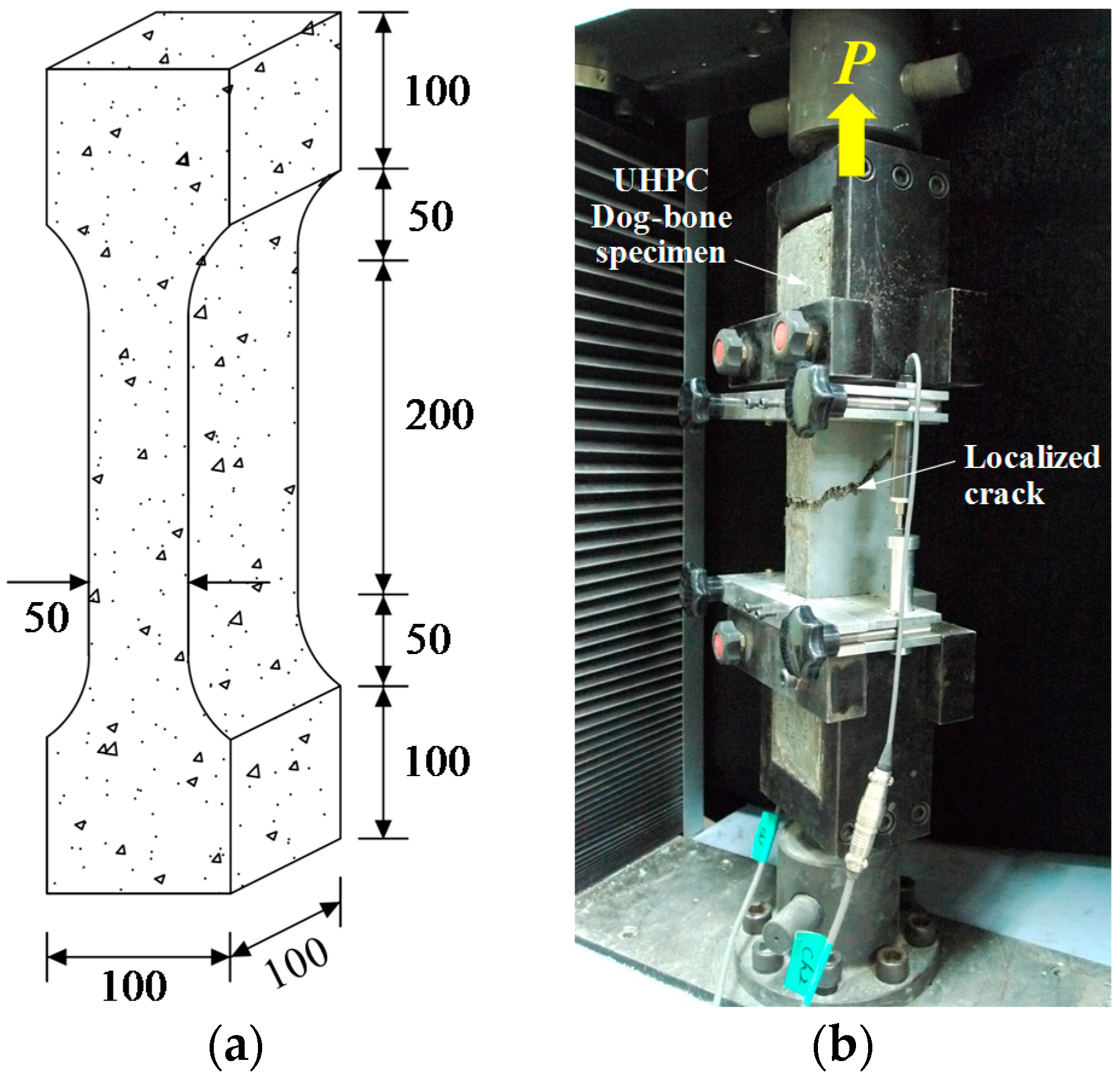
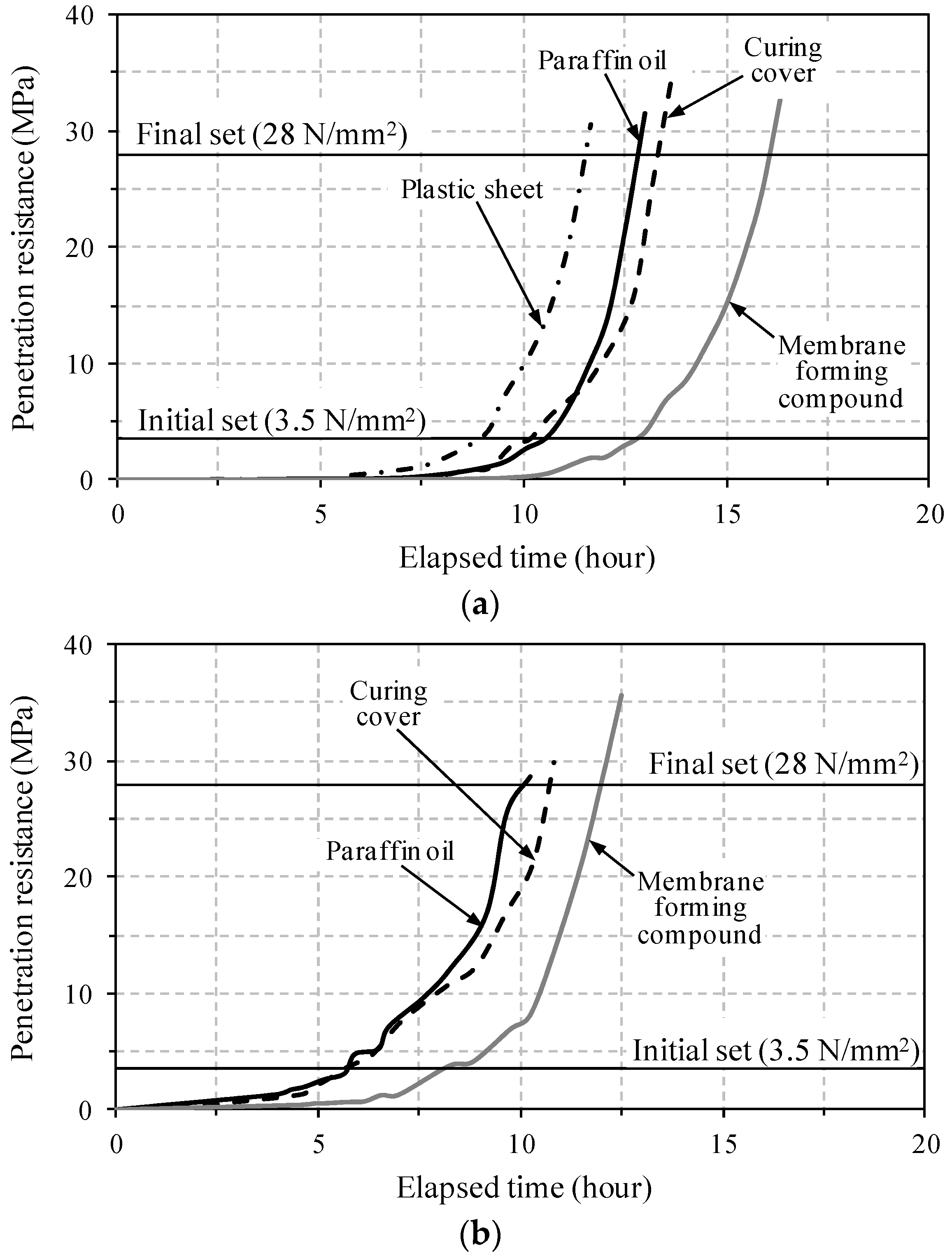
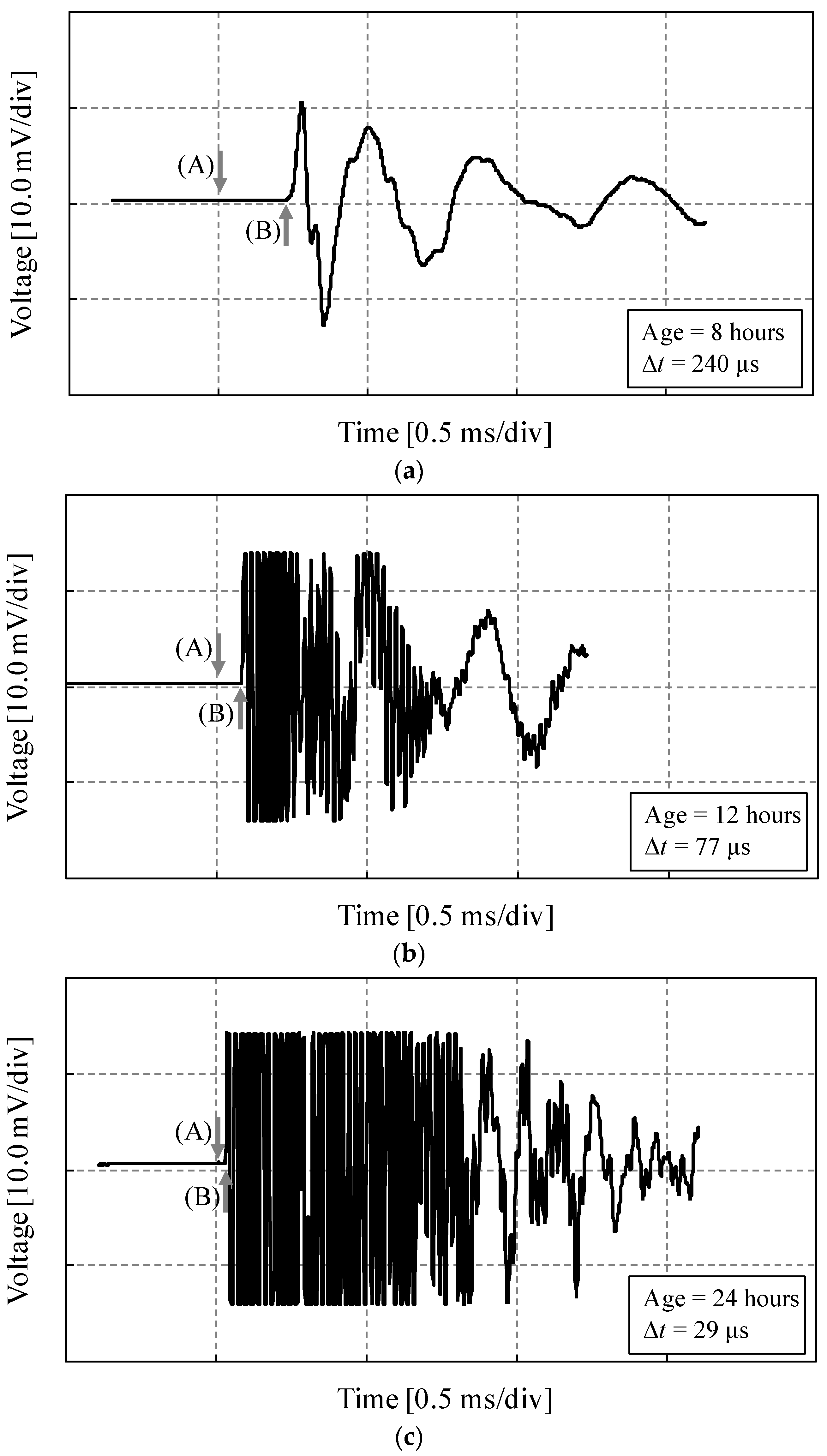
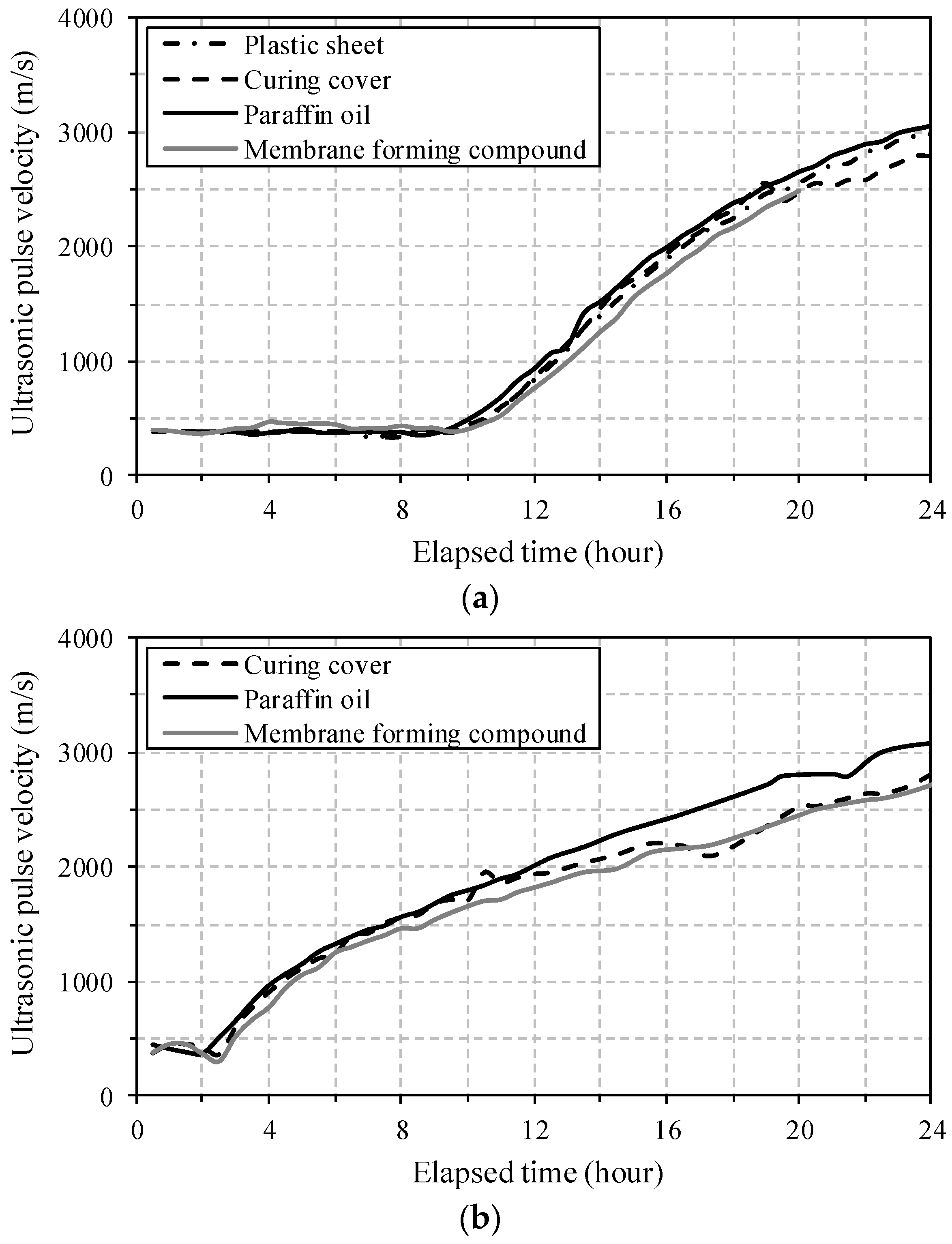
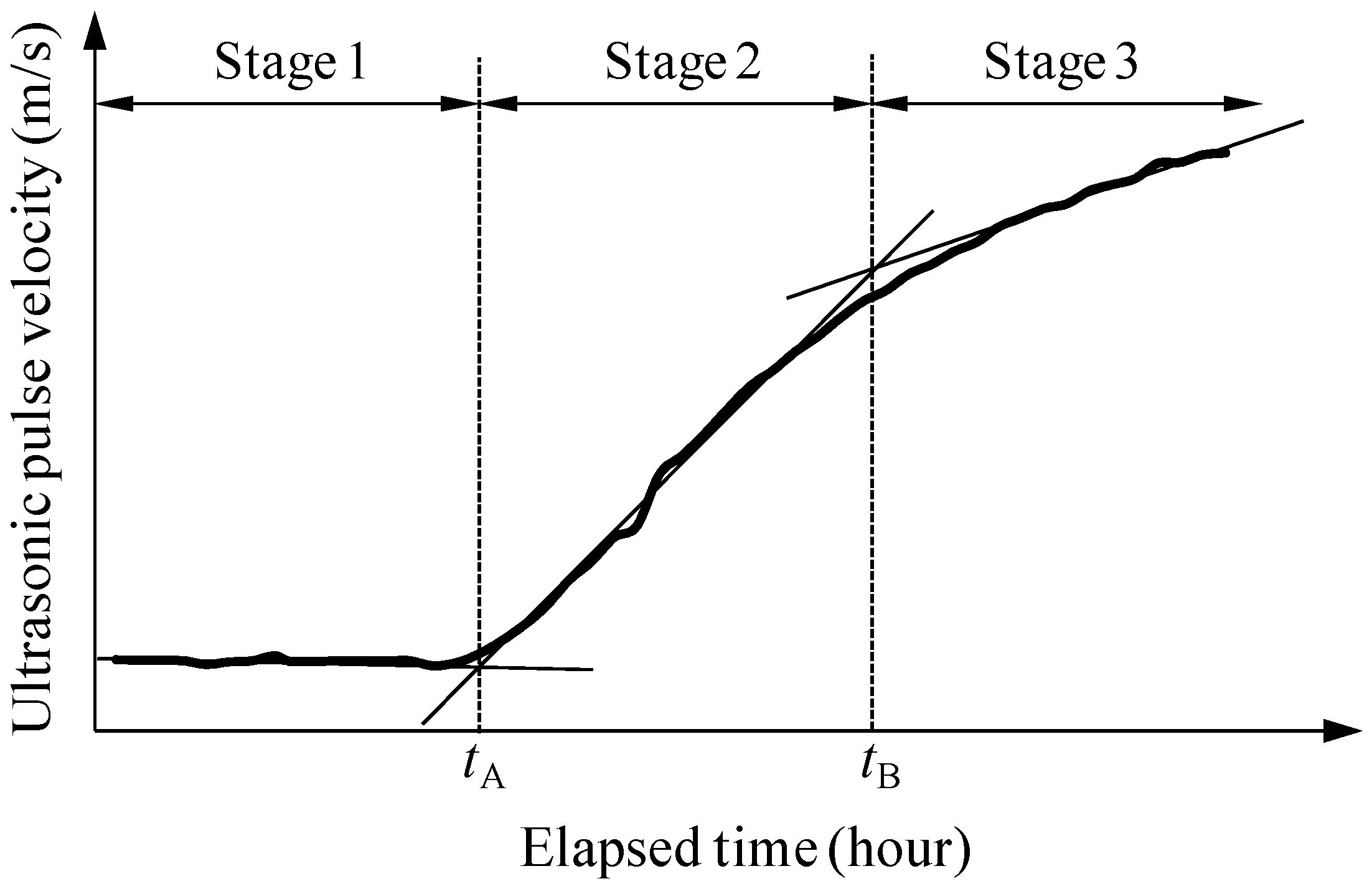
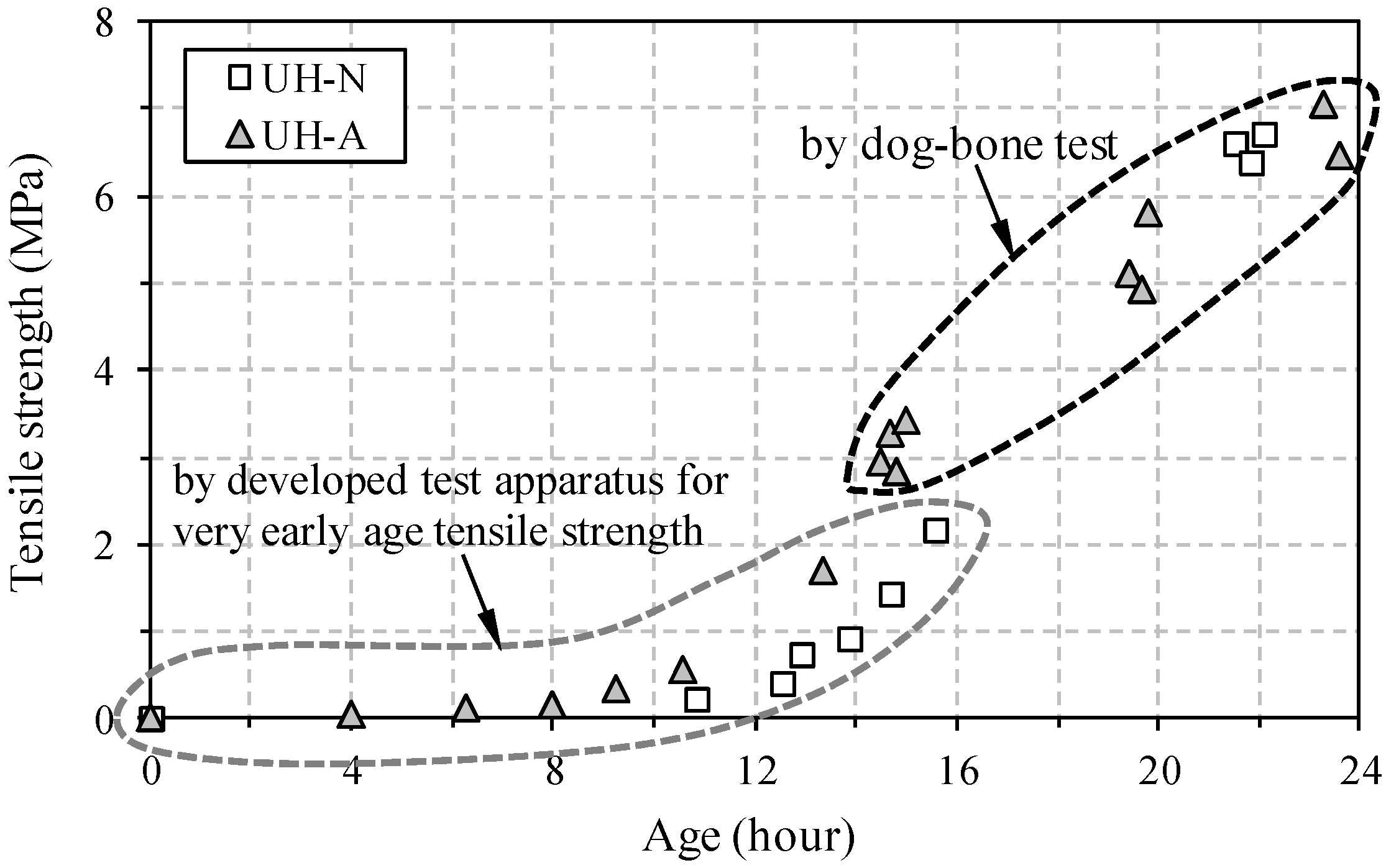
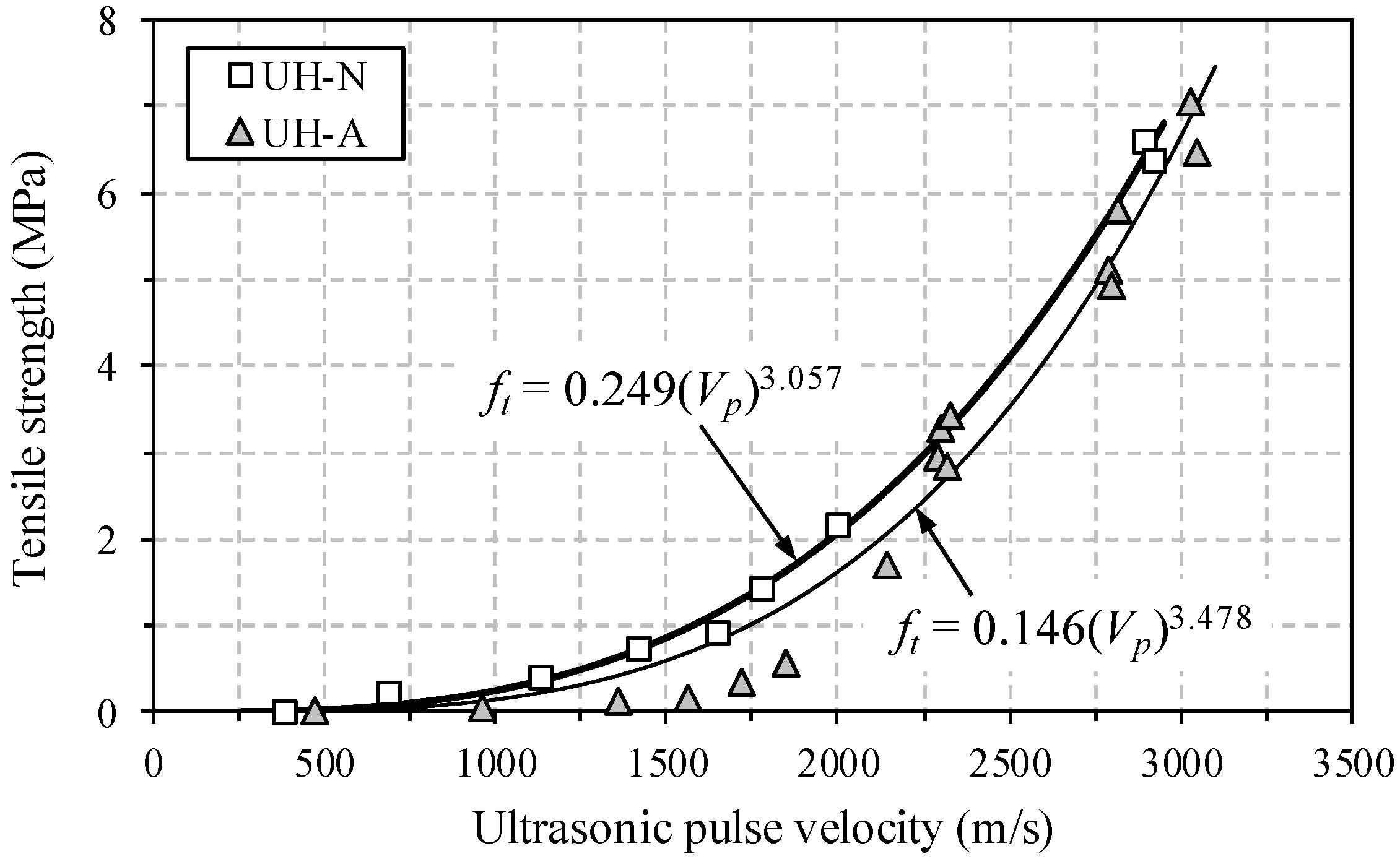
| Specimen | Water | Cement | Silica Fume | Silica Flour | Silica Sand | EA | SRA | SP (%) | Steel Fiber (vf, %) |
|---|---|---|---|---|---|---|---|---|---|
| UH-N | 160.3 | 788.5 | 197.1 | 236.6 | 867.4 | - | - | 1.2 | 2.0 |
| UH-A | 165.5 | 786.6 | 196.7 | 236.0 | 865.3 | 59.0 | 7.9 | 1.2 | 2.0 |
| Composition % (Mass) | Cement | Silica Fume | Expansive Admixture |
|---|---|---|---|
| CaO | 61.33 | 0.38 | 13.55 |
| Al2O3 | 6.40 | 0.25 | 18.66 |
| SiO2 | 21.01 | 96.00 | 3.80 |
| Fe2O3 | 3.12 | 0.12 | - |
| MgO | 3.02 | 0.10 | - |
| SO3 | 2.30 | - | 51.35 |
| K2O | - | - | 0.56 |
| F-CaO | - | - | 16.02 |
| Specific surface (cm2/g) | 3413 | 200,000 | 3117 |
| Density (g/cm3) | 3.15 | 2.10 | 2.98 |
| Diameter df (mm) | Length Lf (mm) | Aspect Ratio (Lf/df) | Density (g/cm3) | Tensile Strength (MPa) | Elastic Modulus (GPa) | Image |
|---|---|---|---|---|---|---|
| 0.2 | 13.0 | 65.0 | 7.9 | 2500 | 200 |  |
| Specimen | Plastic Sheet | Curing Cover | Membrane Forming Compound | Paraffin Oil |
|---|---|---|---|---|
| UH-N | O | O | O | O |
| UH-A | X | O | O | O |
| Specimen | Surface Treatment | Initial Set (Hour) | Final Set (Hour) |
|---|---|---|---|
| UH-N | Plastic sheet | 8.8 | 11.5 |
| Curing cover | 10.2 | 13.2 | |
| Membrane forming compound | 12.8 | 16.0 | |
| Paraffin oil | 10.5 | 12.8 | |
| UH-A | Curing cover | 5.6 | 10.7 |
| Membrane forming compound | 8.0 | 11.9 | |
| Paraffin oil | 5.8 | 10.2 |
| Specimen | tA (Hour) | tB (Hour) |
|---|---|---|
| UH-N | 9.8 | 17.2 |
| UH-A | 2.0 | 5.1 |
© 2016 by the authors; licensee MDPI, Basel, Switzerland. This article is an open access article distributed under the terms and conditions of the Creative Commons Attribution (CC-BY) license (http://creativecommons.org/licenses/by/4.0/).
Share and Cite
Yoo, D.-Y.; Shin, H.-O.; Yoon, Y.-S. Ultrasonic Monitoring of Setting and Strength Development of Ultra-High-Performance Concrete. Materials 2016, 9, 294. https://doi.org/10.3390/ma9040294
Yoo D-Y, Shin H-O, Yoon Y-S. Ultrasonic Monitoring of Setting and Strength Development of Ultra-High-Performance Concrete. Materials. 2016; 9(4):294. https://doi.org/10.3390/ma9040294
Chicago/Turabian StyleYoo, Doo-Yeol, Hyun-Oh Shin, and Young-Soo Yoon. 2016. "Ultrasonic Monitoring of Setting and Strength Development of Ultra-High-Performance Concrete" Materials 9, no. 4: 294. https://doi.org/10.3390/ma9040294
APA StyleYoo, D.-Y., Shin, H.-O., & Yoon, Y.-S. (2016). Ultrasonic Monitoring of Setting and Strength Development of Ultra-High-Performance Concrete. Materials, 9(4), 294. https://doi.org/10.3390/ma9040294







